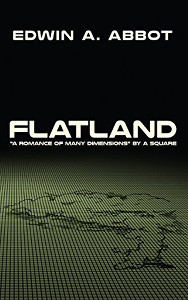 I have finally read “Flatland: A Romance of Many Dimensions” and only then because my mathematically inclined daughter bought me a copy. Even with the slim volume sitting in my TBR pile, I might never have got round to it (I so rarely read paper books these days) had it not happened to be in a collection of classic sci-fi novels in ebook format I picked up for a couple of bucks.
I have finally read “Flatland: A Romance of Many Dimensions” and only then because my mathematically inclined daughter bought me a copy. Even with the slim volume sitting in my TBR pile, I might never have got round to it (I so rarely read paper books these days) had it not happened to be in a collection of classic sci-fi novels in ebook format I picked up for a couple of bucks.
The first thing that struck me about the book is how completely weird the whole thing is. I mean, it’s the first-person account of the life and times of a geometrical figure in a 2-dimensional world who has the misfortune to encounter a geometrical figure from a 3-dimensional world. Can you imagine a 21st Century publisher touching such a thing with a bargepole? I certainly can’t but there was something about the 19th Century that seemed to bring out the experimental in writers. Yes, the bulk of publishing was escapist fun, much as it is today, but there was a quirkiness, a wildness you might say, about those times that produced works of almost unreadable weirdness and wonder like “Moby Dick” and anything by Dostoyevsky. It was a time of experimentation and daring that produced rather odd failures, like “Moll Flanders”, but also brilliant successes, like “The Time Machine”, and “Alice’s Adventures in Wonderland”.
But “Flatland” is out there on its own; weird in a way that makes even “Moby Dick” look normal. The first part of the book establishes not only the geometry of Flatland but also its bizarre social structure, the superiority of regular polygons and the fact that intelligence is directly related to the size of your internal angles. Women, being straight lines, are naturally at the bottom of the social heap (except for those who are too irregular and are executed), The whole species is thus driven by a kind of social Darwinism to achieve perfect circularity.
The second part of the book gets much more mathematical as our hero (called A Square, by the way) sees a one-dimensional world in a vision and is then taken by the sphere into the third dimension and shown a world with no dimensionality at all!
It’s all allegorical, of course, as is most truly weird fiction (at least the authors say it is) but the allegory all has a rather school-masterly tone to it. If I were you, I wouldn’t even bother to puzzle out Abbott’s commentary on social stratification, the battle of the sexes, or the suppression of radical ideas, just read it for the geometry.
It’s fun, I’ve got to say: very weird fun.
Interestingly, the book flopped when it was first published in 1884 but had a revival after Einstein made the idea of a four-dimensional universe popular some thirty years later. Ironically, Einstein’s fourth dimension was time, not an extra space dimension. HG Wells’ short story “The Chronic Argonauts”, published at about the same time, in 1888, does view time as a fourth dimension but didn’t get the same boost from General Relativity (although “The Time Machine”, 1895, using the same idea, did all right for itself). Perhaps Flatland will get another boost if String Theory ever becomes popular.
